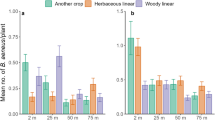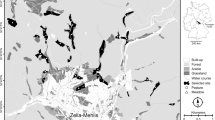Abstract
Studies of patchily distributed insect populations have made clear the importance of host patch size and degree of isolation in determining the distribution of these populations. For such populations, patch connectivity will have an effect on patterns of patch occupancy and regional dynamics. In the present study we performed a series of observations to estimate the effect of landscape structure on the abundance of Delphacodes kuscheli (Homoptera: Delphacidae), vector of “Mal de Río Cuarto” disease to maize. Actively dispersing D. kuscheli individuals were collected in 19 sampling sites during the spring of 2004, using sticky traps placed at 2 m above ground level. Land use and landscape pattern were quantified, using Landsat 5 TM images for the area where each sampling site was placed. Four land use categories were considered in the analysis; winter pastures, winter cereals, perennial pasture and stubble. The spatial pattern analysis program FRAGSTATS was employed to estimate the patch area, patch proximity index, Total Class Area and the Mean Proximity Index for each of the land use categories in those sites where insect samples were taken. Partial Least Squares Regression analysis techniques were employed to relate the mean abundance of D. kuscheli and the landscape measures. Eighty percent of the variation of the mean insect abundance was explained by two first PLSR components. The proximity index of the local host patches, the amount of area left to stubble, local host patch area and total area of winter pastures were the most important variables affecting the abundance of dispersing D. kuscheli individuals. We found that the abundance of the dispersive fraction of the population of D. kuscheli is affected mostly by the surrounding landscape, particularly by the proximity of other host patches, and the permeability of the matrix represented by the stubble.






Similar content being viewed by others
References
Bender DJ, Fahrig L (2005) Matrix structure obscures the relationship between interpatch movement and patch size and isolation. Ecology 86(4):1023–1033
Biedermann R (2002) Leafhoppers (Hemiptera, Auchenorrhyncha) in fragmented habitats. Denisia 4:523–530
Cheng Q, Sun DW (2005) Application of PLSR in correlating physical and chemical properties of pork ham with different cooling methods. Meat Sci 70:691–698
Conci LR, Marzachi C (1993) Avances en la caracterización molecular del genoma del virus causal del “Mal de Río Cuarto” INTA (ed.) Actas Workshop “Mal de Río Cuarto del Maíz”, Instituto Nacional de Tecnología Agropecuaria, Córdoba, Argentina, pp 27–28
Congalton RG, Green K (1999) Assessing the accuracy of classifications of remotely sensed data: principles and practices. Lewis Publishers, New York
Cooper CB, Walters JR, Priddy J (2002) Landscape patterns and dispersal success simulated population dynamics in the brown treecreeper. Ecol Appl 6:1576–1587
Cronin JT (2003) Movement and spatial population structure of a prairie planthopper. Ecology 84:1179–1188
Denno RF, Roderick GK, Olmstead KL, Döbel HG (1991) Density related migration in planthoppers (Homoptera: Delphacidae): the role of habitat persistence. Am Nat 138:1513–1541
Denno RF, Gratton C, Peterson MA, Langellotto GA, Finke DL, Huberty AF (2002) Bottom-up forces mediate natural-enemy impact in a phytophagous insect community. Ecology 83:1443–1458
Döbel HG, Denno RF (1994) Predator-planthopper interactions. In: Denno RF, Perfect TJ (eds) Planthoppers: their ecology and management. Chapman and Hall, New York, pp 325–339
Dunning JB, Borgella R, Clements K, Meffe GK (1995) Patch isolation, corridor effects, and colonization by a resident sparrow in a managed pine woodland. Conserv Biol 9:542–550
Eastman RJ (2006) IDRISI Andes guide to GIS and image processing. ClarkLabs Clark University, Worcester
Enoksson B, Angelstam P, Larsson K (1995) Deciduous forest and resident birds: the problem of fragmentation within a coniferous forest landscape. Landscape Ecol 10:267–275
Fahrig L, Jonsen I (1998) Effect of habitat patch characteristics on abundance and diversity of insects in an agricultural landscape. Ecosystems 1:197–205
Forman RTT, Godron M (1986) Landscape ecology. Wiley, New York
Garat O, Trumper EV, Gorla DE, Perez-Harguindeguy N (1999) Spatial pattern of the Río Cuarto corn disease vector, Delphacodes kuscheli Fennah (Hom. Delphacidae), in oats fields in Argentina and design of sampling plans. J Appl Entomol 123:121–126
Gobeil JF, Villard MA (2002) Permeability of three boreal forest landscape types to bird movements as determined from experimental translocations. Oikos 98:447–458
Goodsel PJ, Connell SD (2008) Complexity in the relationship between matrix composition and inter-patch distance in fragmented habitats. Mar Biol 154:117–125
Goodwin BJ, Fahrig L (2002) Effect of landscape structure on the movement behaviour of a specialized goldenrod beetle, Trirhabda borealis. Can J Zool 80:24–35
Grilli MP (2006) Effect of local land use on populations of a disease vector Planthopper. Environ Entomol 35:1254–1263
Grilli MP (2008) Spatial synchrony of planthopper species with contrasting outbreak behaviour. Agric For Entomol 10:307–314
Grilli MP, Bruno MA (2007) Regional abundance of a planthopper pest: the effect of host patch area and configuration. Entomol Exp Appl 122:133–143
Grilli M, Gorla D (1997) The spatio-temporal pattern of Delphacodes kuscheli (Homoptera: Delphacidae) abundance in central Argentina. Bull Entomol Res 87:45–53
Grilli MP, Gorla DE (1998) The effect of agroecosystem managementon the abundance of Delphacodes kuscheli (Homoptera: Delphacidae), vector of the Maize Rough Dwarf virus, in central Argentina. Maydica 43:77–82
Grilli MP, Gorla DE (1999) The distribution and abundance of Delphacidae (Homoptera) in central Argentina. J Appl Entomol 123:13–21
Gustafson EJ (1998) Quantifying landscape spatial pattern: what is the state of the art. Ecosystems 1:143–156
Gustafson EJ, Parker GR (1992) Relationships between land cover proportion and indices of landscape spatial pattern. Landscape Ecol 7:101–110
Haddad NM, Baum KA (1999) An experimental test of corridor effects on butterfly densities. Ecol Appl 9:623–633
Haddad NM, Tilman D, Haarstad J, Ritchie M, Knops JMH (2001) Contrasting effects of plant richness and composition on insect communities: a field experiment. Am Nat 158:17–35
Hansen SA, Urban DL (1992) Avian response to landscape pattern: the role of species life histories. Landscape Ecol 7:163–182
Hanski I (1994) A practical model of metapopulation dynamics. J Anim Ecol 63:151–162
Hanski I (1999) Metapopulation ecology. Oxford University Press, New York
Hanski I, Gilpin ME (1997) Metapopulation biology. Ecology, genetics, and evolution. Academic Press, San Diego
Haynes KJ, Cronin JT (2003) Matrix composition affects the spatial ecology of a prairie planthopper. Ecology 84:2856–2866
Haynes KJ, Dillemuth FP, Anderson BJ, Hakes AS, Jackson HB, Jackson SE, Cronin JT (2007) Landscape context outweighs local habitat quality in its effects on herbivore dispersal and distribution. Oecologia 151:431–441
Hinsley SA, Bellamy PE, Newton I, Sparks TH (1995) Habitat and landscape factors influencing the presence of individual breeding bird species in woodland fragments. J Avian Biol 26:94–104
Landgrebe DA (2003) Signal theory methods in multispectral remote sensing. Wiley, New Jersey
March G, Balzarini M, Ornaghi J, Beviacqua J, Marinelli A (1995) Predictive model for “Mal de Río Cuarto” disease intensity. Plant Dis 79:1051–1053
Martens H, Naes T (1989) Multivariate calibration. Wiley, New York
McGarigal K, Marks BJ (1995) FRAGSTATS: spatial pattern analysis program for quantifying landscape structure. Gen. Tech. Report PNW-GTR-351, USDA Forest Service, Pacific Northwest Research Station, Portland, Oregon
Ornaghi J, Boito G, Sanchez G, March G, Beviacqua J (1993) Studies on the population of Delphacodes kuscheli Fennah in different years and agricultural areas. J Genet Breed 47:227–282
Pulliam HR (1988) Sources, sinks, and population regulation. Am Nat 132:652–661
Pulliam HR (1996) Sources and sinks: empirical evidence and population consequences. In: Rhodes OE Jr, Chesser RK, Smith MH (eds) Population dynamics in ecological space and time. Univ. of Chicago Press, Chicago, pp 45–69
Pulliam HR, Danielson BJ (1991) Sources, sinks, and habitat selection: a landscape perspective on population dynamics. Am Nat 137:50–66
Remes Lenicov AM, Virla E (1999) Delfácidos asociados al cultivo de maíz en la República Argentina (Insecta—Homoptera—Delphacidae) Revista de la Facultad de Agronomía, La Plata 104: 1–16
Remes Lenicov AM, Laguna IG, Rodriguez Pardina P, Mariani R, Virla E, Herrera P, Dagoberto E (1999) Diagnóstico del virus del “Mal de Río Cuarto” y sus vectores en maíz en Argentina. Manejo Integrado de Plagas 51:36–46
Ricketts TH (2001) The matrix matters: effective isolation in fragmented landscapes. Am Nat 158:87–99
Roland J, Keyghobadi N, Fownes S (2000) Alpine Parnassius butterfly dispersal: effects of landscape and population size. Ecology 81:1642–1653
Sabins FF (1997) Remote sensing—principles and interpretation. W.H. Freeman and Company, New York
Shmida A, Ellner S (1984) Coexistence of plant species with similar niches. Vegetatio 58:29–55
Sjögren Gulve P (1994) Distribution and extinction patterns within a northern metapopulation of the pool frog, Rana lessonae. Ecology 75:1357–1367
Stacey PB, Johnson VA, Taper ML (1997) Migration within metapopulations: the impact upon local population dynamics. In: Hanski I, Gilpin ME (eds) Metapopulation biology: ecology, genetics and evolution. Academic Press, San Diego, pp 267–291
StatSoft Inc (2001) STATISTICA for Windows [Computer program manual]. Tulsa, OK: StatSoft, Inc., 2300 East 14th Street, Tulsa, OK 74104, phone: (918) 749-1119, fax: (918) 749-2217
Taylor PD, Fahrig L, Henein K, Merriam G (1993) Connectivity is a vital element of landscape structure. Oikos 68:571–573
Tenenhaus M (1998) La Regression PLS: Theorie et Pratique. Technip, Paris
Tesón A, Remes Lenicov A, Dagoberto E, Paradel S (1986) Estudio de las poblaciones de delfácido sobre maíz, avena y malezas circundantes (Homoptera, Fulgoridae). Gaceta Agronómica 7:507–517
Tewksbury JJ, Levey JD, Haddad NM, Sargent S, Orrock JL, Weldon A, Danielson BJ, Brinkerhoff J, Damschen EI, Townsend P (2002) Corridors affect plants, animals, and their interactions in fragmented landscapes. Proc Natl Acad Sci USA 99:12923–12926
Tilman D, Kareiva P (1997) Spatial ecology: the role of space in population dynamics and interspecific interactions. Princeton University Press, Princeton
Tischendorf L, Fahrig L (2000) On the usage and measurement of landscape connectivity. Oikos 90:7–19
Tischendorf L, Bender DJ, Fahrig L (2003) Evaluation of patch isolation metrics in mosaic landscapes for specialist vs. generalist dispersers. Landscape Ecol 18:41–50
Virla EG, Remes Lenicov AM (1991) Ciclo de vida de Delphacodes kuscheli sobre diferentes hospedantes en condiciones de laboratorio. Taller de Actualización sobre Mal de Río Cuarto, (ed. by INTA) Pergamino, Buenos Aires, Argentina, pp 104–116
Virnstein RW, Curran MC (1986) Colonization of artificial seagrass versus time and distance from source. Mar Ecol Prog Ser 29:279–288
Wiens JA (1992) Ecological flows across landscape boundaries: a conceptual overveiw. In: Hansen AJ, di Castro F (eds) Landscape boundaries: consequences for biotic dievrsity and ecological Xows. Springer, New York, pp 217–235
Wiens JA (1997) Metapopulation dynamics and landscape ecology. In: Hanski IA, Gilpin ME (eds) Metapopulation biology: ecology, genetics, and evolution. Academic Press, San Diego, pp 43–67
Wiens JA, Stenseth NC, Van Horne B, Ims RA (1993) Ecological mechanisms and landscape ecology. Oikos 66:369–380
Wold S, Albano C, Dunn III WJ, Edlund U, Eliasson B, Johansson E, Norden B, Sjöström M (1982) The indirect observation of molecular chemical systems. In: K.-G. Jöreskog, H. Wold (Eds.), Systems under indirect observation, vols. I and II, North-Holland, Amsterdam, 1982, pp 177–207, Chapter 8
Wold S, Sjöström M, Eriksson L (2001) PLS-regression: a basic tool of chemometrics. Chemometrics Intell Lab 58:109–130
Acknowledgments
This work was carried out with a grant provided by the Fondo Nacional de Ciencia y Técnica BID 1201/OC—AR PICT 08-12497. I would especially like to thank Joss Heywood for checking the language, A. Barbeito for the drawings, CONAE (National Space Commission, Argentina) for the provision of satellite imagery under “PlagaSat” project and to two anonymous reviewers for the useful suggestions that improved an earlier version of this paper.
Author information
Authors and Affiliations
Corresponding author
Rights and permissions
About this article
Cite this article
Grilli, M.P. The role of landscape structure on the abundance of a disease vector planthopper: a quantitative approach. Landscape Ecol 25, 383–394 (2010). https://doi.org/10.1007/s10980-009-9422-0
Received:
Accepted:
Published:
Issue Date:
DOI: https://doi.org/10.1007/s10980-009-9422-0




